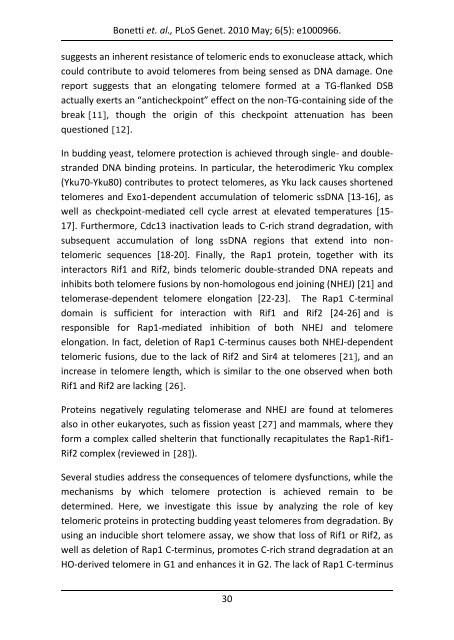View/Open - Università degli Studi di Milano-Bicocca
View/Open - Università degli Studi di Milano-Bicocca
View/Open - Università degli Studi di Milano-Bicocca
You also want an ePaper? Increase the reach of your titles
YUMPU automatically turns print PDFs into web optimized ePapers that Google loves.
Bonetti et. al., PLoS Genet. 2010 May; 6(5): e1000966.<br />
suggests an inherent resistance of telomeric ends to exonuclease attack, which<br />
could contribute to avoid telomeres from being sensed as DNA damage. One<br />
report suggests that an elongating telomere formed at a TG-flanked DSB<br />
actually exerts an “anticheckpoint” effect on the non-TG-containing side of the<br />
break [11], though the origin of this checkpoint attenuation has been<br />
questioned [12].<br />
In bud<strong>di</strong>ng yeast, telomere protection is achieved through single- and doublestranded<br />
DNA bin<strong>di</strong>ng proteins. In particular, the hetero<strong>di</strong>meric Yku complex<br />
(Yku70-Yku80) contributes to protect telomeres, as Yku lack causes shortened<br />
telomeres and Exo1-dependent accumulation of telomeric ssDNA [13-16], as<br />
well as checkpoint-me<strong>di</strong>ated cell cycle arrest at elevated temperatures [15-<br />
17]. Furthermore, Cdc13 inactivation leads to C-rich strand degradation, with<br />
subsequent accumulation of long ssDNA regions that extend into nontelomeric<br />
sequences [18-20]. Finally, the Rap1 protein, together with its<br />
interactors Rif1 and Rif2, binds telomeric double-stranded DNA repeats and<br />
inhibits both telomere fusions by non-homologous end joining (NHEJ) [21] and<br />
telomerase-dependent telomere elongation [22-23]. The Rap1 C-terminal<br />
domain is sufficient for interaction with Rif1 and Rif2 [24-26] and is<br />
responsible for Rap1-me<strong>di</strong>ated inhibition of both NHEJ and telomere<br />
elongation. In fact, deletion of Rap1 C-terminus causes both NHEJ-dependent<br />
telomeric fusions, due to the lack of Rif2 and Sir4 at telomeres [21], and an<br />
increase in telomere length, which is similar to the one observed when both<br />
Rif1 and Rif2 are lacking [26].<br />
Proteins negatively regulating telomerase and NHEJ are found at telomeres<br />
also in other eukaryotes, such as fission yeast [27] and mammals, where they<br />
form a complex called shelterin that functionally recapitulates the Rap1-Rif1-<br />
Rif2 complex (reviewed in [28]).<br />
Several stu<strong>di</strong>es address the consequences of telomere dysfunctions, while the<br />
mechanisms by which telomere protection is achieved remain to be<br />
determined. Here, we investigate this issue by analyzing the role of key<br />
telomeric proteins in protecting bud<strong>di</strong>ng yeast telomeres from degradation. By<br />
using an inducible short telomere assay, we show that loss of Rif1 or Rif2, as<br />
well as deletion of Rap1 C-terminus, promotes C-rich strand degradation at an<br />
HO-derived telomere in G1 and enhances it in G2. The lack of Rap1 C-terminus<br />
30

















